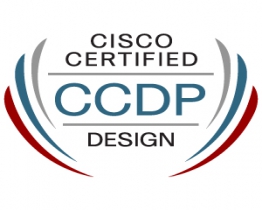
CCDP Cisco Certified Design Professional
Enterprise environments require networks designed for performance, availability and scalability to achieve outcomes. Seasoned IT professionals with progressive end-to-end network design expertise are crucial to ensure networks deliver to today's requirements while future proofing investments. For Senior Network Design Engineers, Principle System Engineer, Network/Solution Architects and CCDA professionals looking to build upon your fundamental Cisco network design expertise the Cisco CCDP certification program focuses on advanced addressing and routing protocols, WANs, services virtualization, and integration strategies for multi-layered Enterprise architectures.
300-101 ROUTE
Pre-requisites: CCNA (R&S)
Layer 2 Technologies
1.1 Configure and verify PPP
1.2 Explain Frame Relay (Operations, Point to Point, Multipoint)
Layer 3 Technologies
2.1 Identify, configure, and verify IPv4 addressing and subnetting
2.2 Identify IPv6 addressing and subnetting
- Unicast
- EUI-64
- ND, RS/RA
- Autoconfig (SLAAC)
2.3 Configure and verify static routing
2.4 Configure and verify default routing
2.5 Evaluate routing protocol types
2.6 Describe administrative distance
2.7 Configure and verify VRF lite
2.8 Configure and verify filtering with any protocol
2.9 Configure and verify redistribution between any routing protocols or routing sources
2.10 Configure and verify manual and autosummarization with any routing protocol
2.11 Configure and verify policy-based routing
2.12 Identify suboptimal routing
2.13 Explain ROUTE maps
2.14 Configure and verify loop prevention mechanisms
2.15 Configure and verify RIPv2
2.16 Describe RIPng
2.17 Describe EIGRP packet types
2.18 Configure and verify EIGRP neighbor relationship and authentication
2.19 Configure and verify EIGRP stubs
2.20 Configure and verify EIGRP load balancing
2.21 Describe and optimize EIGRP metrics
2.22 Configure and verify EIGRP for IPv6
2.23 Describe OSPF packet types
2.24 Configure and verify OSPF neighbor relationship and authentication
2.25 Configure and verify network types, area types, and router types
2.26 Configure and verify OSPF path preference
2.27 Configure and verify OSPF operations
2.28 Configure and verify OSPF for IPv6
2.29 Describe, configure, and verify BGP peer relationships and authentication
2.30 Configure and verify eBGP
2.31 Explain BGP attributes and best-path selection
VPN Technologies
3.1 Configure and verify GRE
3.2 Describe DMVPN (single hub)
Infrastructure Security
4.1 Describe IOS AAA using local database
4.2 Describe device security using IOS AAA with TACACS+ and RADIUS
4.3 Configure and verify device access control
- Configure and verify router security features
Infrastructure Services
5.1 Configure and verify device management
5.2 Configure and verify SNMP
5.3 Configure and verify logging
5.4 Configure and verify Network Time Protocol (NTP)
5.5 Configure and verify IPv4 and IPv6 DHCP
5.6 Configure and verify IPv4 Network Address Translation (NAT)
5.7 Configure and verify IP SLA
5.8 Configure and verify Cisco NetFlow
300-115 SWITCH
Pre-requisites: CCNA (R&S)
Layer 2 Technologies
1.1 Configure and verify switch administration
1.2 Configure and verify Layer 2 protocols
1.3 Configure and verify VLANs
1.4 Configure and verify trunking, VTP
1.5 Configure and verify EtherChannels
1.6 Configure and verify spanning tree
1.7 Configure and verify other LAN switching technologies (SPAN)
1.8 Describe chassis virtualization and aggregation technologies (Stackwise)
Infrastructure Security
2.1 Configure and verify switch security features
- DHCP snooping
- IP Source Guard
- Dynamic ARP inspection
- Port security
- Private VLAN
- Storm control
Infrastructure Services
3.1 Configure and verify first-hop redundancy protocols
- HSRP
- VRRP
- GLBP
300-320 ARCH
Pre-requisites: CCNP (R&S), Knowledge of Cisco Data Center Technologies, Cisco Security, Service Provider & Collaboration Technologies
Advanced Addressing and Routing Solutions for Enterprise Networks
1.1 Create structured addressing designs to facilitate summarization
1.2 Create stable, secure, and scalable routing designs for IS-IS
1.3 Create stable, secure, and scalable routing designs for EIGRP
1.4 Create stable, secure, and scalable routing designs for OSPF
1.5 Create stable, secure, and scalable routing designs for BGP
1.6 Determine IPv6 migration strategies (dual-stacking)
Advanced Enterprise Campus Networks
2.1 Design for high availability (FHRP)
2.2 Design campus Layer 2 infrastructures
- STP scalability
- Fast convergence
- Loop-free technologies
WANs for Enterprise Networks
3.1 Compare and contrast WAN connectivity options
- Dynamic Multipoint VPN (DMVPN)
- Layer 2 VPN
- MPLS Layer 3 VPN
- IPsec
- Generic Routing Encapsulation (GRE)
- Private lines
3.2 Design site-to-site VPNs
- DMVPN
- Layer 2 VPN
- MPLS Layer 3 VPN
- IPSec
- Group Encrypted Transport VPN (GETVPN)
3.3 Design for a resilient WAN strategy
- Single-homed
- Multi-homed
- Backup connectivity
- Failover
3.4 Design Internet edge connectivity
- DMZ
- NAT
Enterprise Data Center Integration
4.1 Describe a modular and scalable data center network
- Top-of-rack
- End-of-row
- Multitenant environments
- Multitier topologies
4.2 Describe network virtualization technologies for the data center
- VPC
- VSS
- VDCs
- VRFs
- Multichassis EtherChannel
- VXLAN
- TRILL / Fabric Path
4.3 Describe high availability in a data center network
- VPC
- VSS
- Multichassis EtherChannel
4.4 Design data center interconnectivity
- OTV
- Private Line
- L2 vs. L3
4.5 Design data center and network integration
- Traffic flow
- Bandwidth
- Security
- Resiliency
Security Services
5.1 Design firewall and IPS solutions
- Modes of operation
- Clustering
- High availability techniques
- IPS functionality and placement
- Multiple contexts
5.2 Design network access control solutions
- 802.1x
- TrustSec
- EAP
- Authentication services
- RBAC
- Basic denial of service mitigation techniques
5.3 Design infrastructure protection
- Infra structure ACLs
- CoPP
- Layer 2 / Layer 3 security considerations
Network Services
6.1 Select appropriate QoS strategies to meet customer requirements
- DiffServ
- IntServ
6.2 Design end-to-end QoS policies
- Classification and marking
- Shaping
- Policing
- Queuing
6.3 Describe network management techniques
- In-band vs. out-of-band
- Segmented management networks
- Prioritizing network management traffic
6.4 Describe multicast routing concepts
- Source trees, shared trees
- Rendezvous points
6.5 Design multicast services
- SSM
- PIM bidirectional
- MSDP

